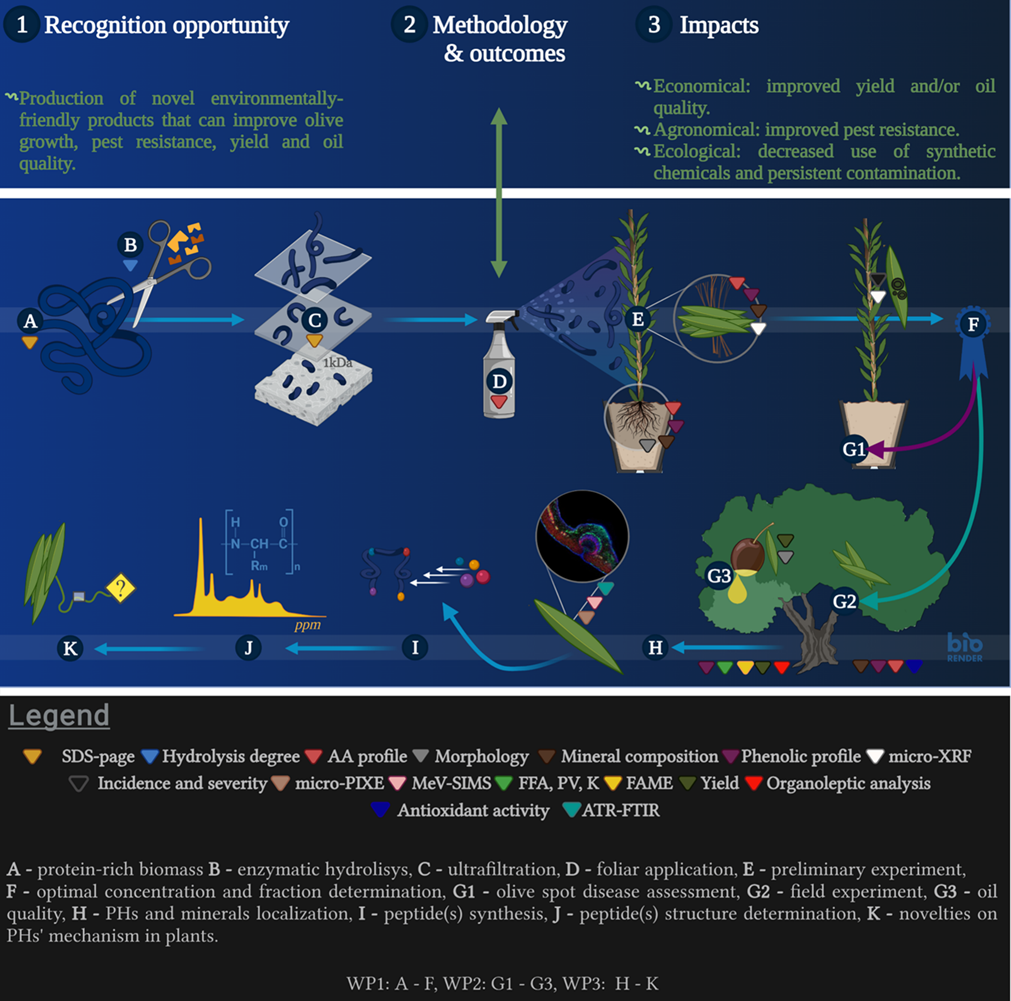Acronym
PROGRESS
Department:
Department of Biology
Type of project
ARIS projects
Type of project
Weave
Role
Lead
Duration
01.01.2024 - 31.12.2027
Total
0,8 FTE
Total
€74,949.60
Project manager at BF
Pongrac PaulaAbstract
A key challenge of modern agriculture is to increase productivity to feed the growing global population while reducing negative impacts on the environment and human health. Biostimulants are environmentally-friendly compounds which, applied at small dose, have a positive impact on plant fitness and resistance to pests without harming the environment. An effective biostimulant represents a green alternative to synthetic chemicals used in plant nutrition and protection. The aim of the project is to design a novel plant-derived biostimulant composed of protein hydrolysates (PHs) for the use in sustainable olive production. Particularly, protein-rich biomass wastes will be used to prepare PHs, which will be then characterised in detail in a preliminary experiment in order to optimize preparation steps and dosage for field experiments. In field experiments the selected PHs will be applied on olive trees and plants’ performance will be monitored through the differences in composition of minerals and primary and secondary metabolites. In addition, fruit yield and the amount and quality of virgin olive oil will be determined. Furthermore, the penetration depth of the PHs applied on the leaves will be studied using state-of-the-art molecular imaging (Attenuated Total Reflection-Fourier Transform Infrared microscopy and MeV-Secondary Ion Mass Spectrometry) which will, accompanied by mineral distribution imaging (micro-Particle-Induced X-ray Emission), enable resolving the mode-of-action of the PHs. The imaging techniques listed offer similar resolution (in micrometre range) and profiling (more than one molecule and/ or mineral is determined simultaneously), making them a combination of choice to perform multi-modal imaging, i.e. imaging on the same sample, sequentially. Structure of so identified PHs will be confirmed by comparing their nuclear magnetic resonance and mass spectra with those obtained by solid-phase peptide synthesis. Finally, the PHs effect on olive spot disease will be tested in a greenhouse experiment, where redistribution of elements around the symptomatic necrotic spots will be determined using micro-X-Ray Fluorescence imaging. Comprising four work packages and eleven tasks the project will engage an interdisciplinary team comprising national and international experts in their respective fields, to deliver knowledge required by plant biologists, agronomists, farmers and nutritionists. Numerous opportunities to participate in outreach activities within the institutes and universities participating will permit the interaction with general public, promote the importance of green tools for healthy ecosystems and communities, and promote the significance to address scientific questions in an interdisciplinary way. The project will enable extensive knowledge exchange by offering open-access to all results and will allow training of PhD students and early career scientists to obtain unique set of technical skills in cutting-edge technologies and to develop communication skills (written and oral) as well as project-management qualities. Finally, workflow and recommendations for the use of biostimulants across agro-industry will be compiled and made available.

The phases of the project and their realization
Objective 1. To design protein hydrolysates (PHs) derived from agricultural waste by using commercially available enzymes and to separate obtained products by molecular weight.
Objective 2. To test the effects of PHs applied foliarly to olive trees on their health and the chemical composition of their leaves, fruit yield and quality of oil.
Objective 3. To localise PHs at cell-type level in leaves to identify those with the best penetration and to uncover the mechanisms of their action.
Objective 4. To localise minerals at cell-type level in leaves to capture the effects of PHs on mineral nutrition of olive trees examined.
Objective 5. To create recommendations for further work, and application of the work to safely and greenly create new biostimulants, for use across agro-industries
